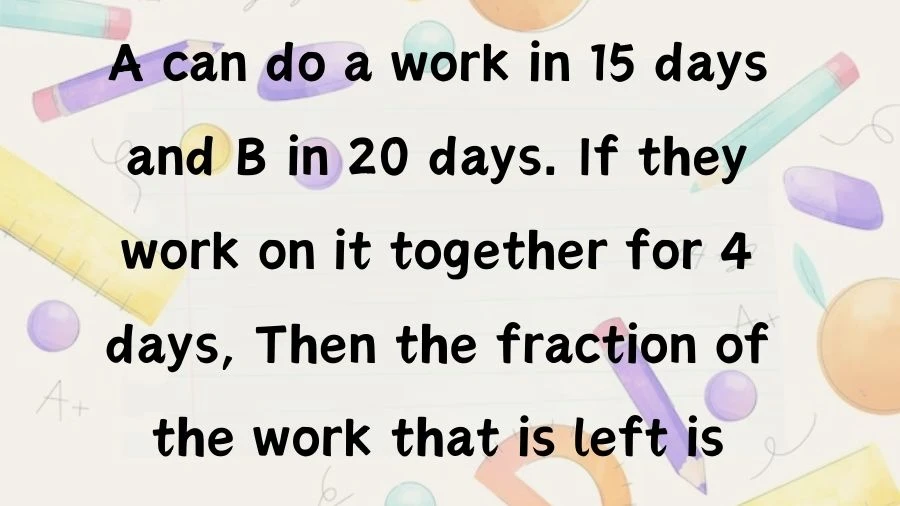If you happen to be viewing the article A can do a work in 15 days and B in 20 days. If they work on it together for 4 days, Then the fraction of the work that is left is ? on the website Math Hello Kitty, there are a couple of convenient ways for you to navigate through the content. You have the option to simply scroll down and leisurely read each section at your own pace. Alternatively, if you’re in a rush or looking for specific information, you can swiftly click on the table of contents provided. This will instantly direct you to the exact section that contains the information you need most urgently.
See how A and B team up to get a job done in 4 days! Find out how much of the work is still left to do and learn about their teamwork.
A can do a work in 15 days and B in 20 days. If they work on it together for 4 days, Then the fraction of the work that is left is
The Fraction of the work that is left is 8/15.
Explanation
Here’s how to find the fraction of the work that is left:
-
Calculate the individual rates of A and B:
- A’s 1 day’s work = 1/15
- B’s 1 day’s work = 1/20
-
Combine their rates to find their combined rate:
- Combined rate = A’s rate + B’s rate = 1/15 + 1/20 = 7/60
-
Calculate the amount of work they do together in 4 days:
- Work done = combined rate * number of days = (7/60) * 4 = 7/15
-
Find the remaining work:
- Total work – work done = 1 (entire work) – 7/15 = 8/15
Therefore, the fraction of the work that is left is 8/15.
Alternatively, you can use a shortcut:
- The fraction of work A can do in a day is 1/15, so in 4 days, he can do 4/15 of the work.
- Similarly, B can do 4/20 of the work in 4 days.
- Together, they can do 4/15 + 4/20 = 7/15 of the work in 4 days.
- This means 1 – 7/15 = 8/15 of the work is left.
So, whichever method you use, the answer remains the same: 8/15 of the work is left.
Importance of Time and Work Related Problems in Mathematics
Time and work-related problems in mathematics play a crucial role in various fields and real-life situations. Understanding these concepts is essential for effective time management, resource allocation, and productivity. Here are some reasons why time and work problems are important:
Project Planning and Management:
In project management, time and work problems help in estimating the time required to complete a project based on the work to be done.
Managers can allocate resources efficiently, set realistic deadlines, and monitor progress effectively.
Productivity and Efficiency:
Time and work problems assist in evaluating the efficiency of individuals or teams by determining how much work they can complete in a given time frame.
It helps in identifying bottlenecks and areas for improvement to enhance overall productivity.
Resource Allocation:
Businesses and organizations need to allocate resources such as manpower, equipment, and funds efficiently.
Time and work problems aid in optimizing resource allocation, ensuring that the right amount of resources is assigned to each task.
Scheduling and Timetables:
Time and work concepts are fundamental in creating schedules and timetables for various activities, whether it be in schools, businesses, or events.
Proper scheduling ensures that tasks are completed on time and that there is a smooth flow of activities.
Cost Estimation:
Time and work problems help in estimating costs associated with completing a task or project.
Businesses can budget more accurately, preventing cost overruns and financial challenges.
Competitive Examinations:
Many competitive exams, especially in fields like banking and government services, include questions related to time and work problems.
Candidates are tested on their ability to solve problems involving time constraints and varying rates of work.
Daily Life and Personal Planning:
Individuals use time and work concepts in their daily lives for personal planning, such as managing household chores, setting study schedules, or planning events.
It helps in making informed decisions about how to allocate time and effort effectively.
Mathematical Skill Development:
Solving time and work problems enhances mathematical and analytical skills.
It requires the application of arithmetic, algebraic, and logical reasoning to arrive at solutions.
In summary, time and work-related problems in mathematics are practical and applicable in various aspects of life, ranging from project management and resource allocation in businesses to personal planning and competitive examinations. Mastery of these concepts is valuable for making informed decisions and optimizing efficiency in different scenarios.
Thank you so much for taking the time to read the article titled A can do a work in 15 days and B in 20 days. If they work on it together for 4 days, Then the fraction of the work that is left is written by Math Hello Kitty. Your support means a lot to us! We are glad that you found this article useful. If you have any feedback or thoughts, we would love to hear from you. Don’t forget to leave a comment and review on our website to help introduce it to others. Once again, we sincerely appreciate your support and thank you for being a valued reader!
Source: Math Hello Kitty
Categories: Math

